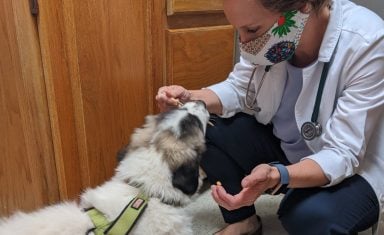With warmer weather upon us, people and pets alike are spending more time outdoors. While sunshine and fresh air can promote a healthier lifestyle, it is important that we protect our pets — and ourselves — against one of the fastest growing tick-borne diseases in our area: Lyme disease.
L — Lyme Disease is Carried Primarily By Deer Ticks, also Known as Black-Legged Ticks
These ticks carry a bacteria called Borrelia burgdorferi which causes Lyme disease. The tick passes this bacteria into its victim as it feeds over a period of time. Deer ticks can range in size from a poppy seed to a sesame seed. It is very difficult to see these ticks once they are on most pets. Lyme disease cannot be contracted directly between sick pets but must go through the deer tick first.
Lyme disease has been noted in humans, dogs, horses, and cats. In small animal medicine, we focus on Lyme disease in dogs. Symptoms in dogs may include fever, lethargy, acute lameness, and sometimes kidney inflammation progressing to acute kidney failure. While blood tests from cats can show that they have been exposed to Borrelia burgdorferi, internal medicine specialists are divided over whether or not cats actually can become noticeably ill or if they are resistant to clinical disease.
Y — Your Area May Be A New Habitat For Ticks Carrying Lyme Disease
Recent studies indicate that veterinarians have seen an exponential rise in the number of cases of Lyme disease over the past four years. Experts think this is because of the expansion of the range of the deer tick into areas it previously did not inhabit.
Lyme disease is now regularly found in our area. Most veterinarians test for exposure to Lyme disease each year when they perform annual heartworm combination tests. These tests not only check for heartworm disease, but also exposure to Lyme disease and other tick-borne diseases.
M — Maintaining Your Pet’s Tick Control Year-Round Is The Best Way To Prevent Lyme Disease
Deer ticks will feed anytime temperatures are above freezing so do not assume because it is winter that your pet is safe. Tick control kills the ticks your pet comes in contact with so that they cannot bite your pet. Nor can they hitch a ride on your pet and hop over to you.
Controlling ticks is not just helpful in preventing Lyme disease. Ticks can carry many other pathogens. Deer ticks are carriers of at least five pathogens that can cause various diseases. Please ask your veterinarian what products they recommend for tick control. Ticks can become resistant to products over time and some products do not kill the deer tick. Your veterinarian will know what products tend to work best in your area.
A second layer of protection in the prevention of Lyme disease is vaccination. Dogs at increased risk of tick exposure may need to be vaccinated. Talk to your veterinarian to see if vaccination is right for your pet.
E — Exposure To The Bacteria That Causes Lyme Might Not Cause Any Symptoms
While antibiotics do exist to treat dogs with Lyme disease, some dogs develop latent infections that appear to go away and then recur periodically throughout their lifetime. Prevention is the best way to ensure your pet stays safe from this disease. Also, if you are killing the ticks your pet comes in contact with, they cannot bring those same ticks home to you.
If your pet goes outside, even just into the backyard, then it is a candidate for tick protection. Contact your veterinarian to get your pet a prescription.
— Dr. Angie DeRosa, DVM
Companion Animal Clinic has been serving Blacksburg, Virginia and surrounding Montgomery and Christiansburg communities since 1974. We are an AAHA accredited veterinary hospital and provide quality, professional care for dogs, cats, exotics, and small mammals. Learn more about our amazing team.





